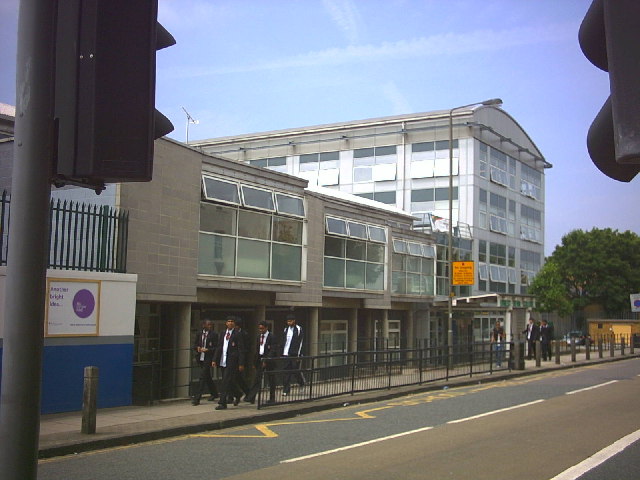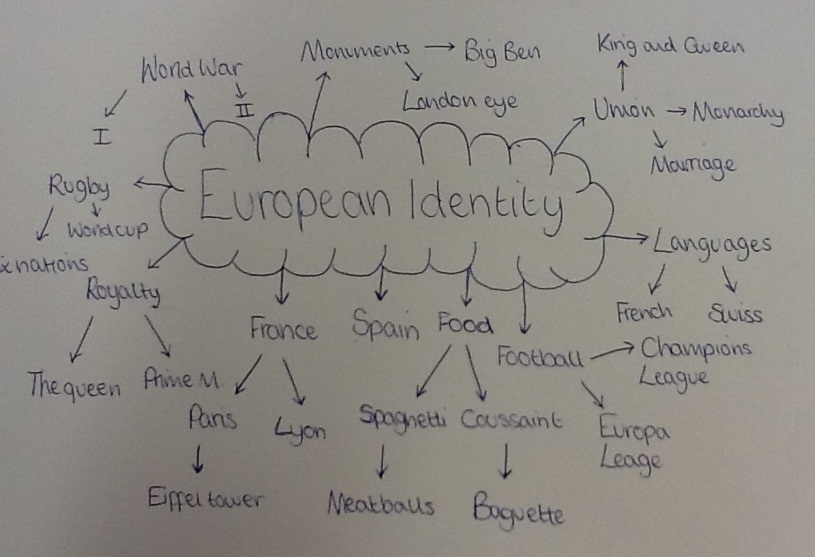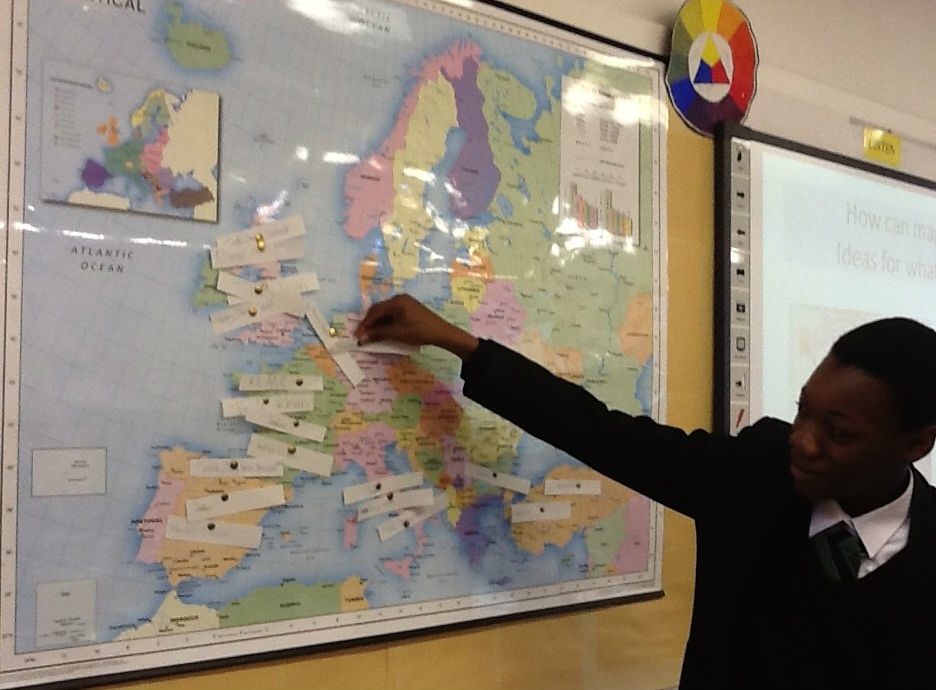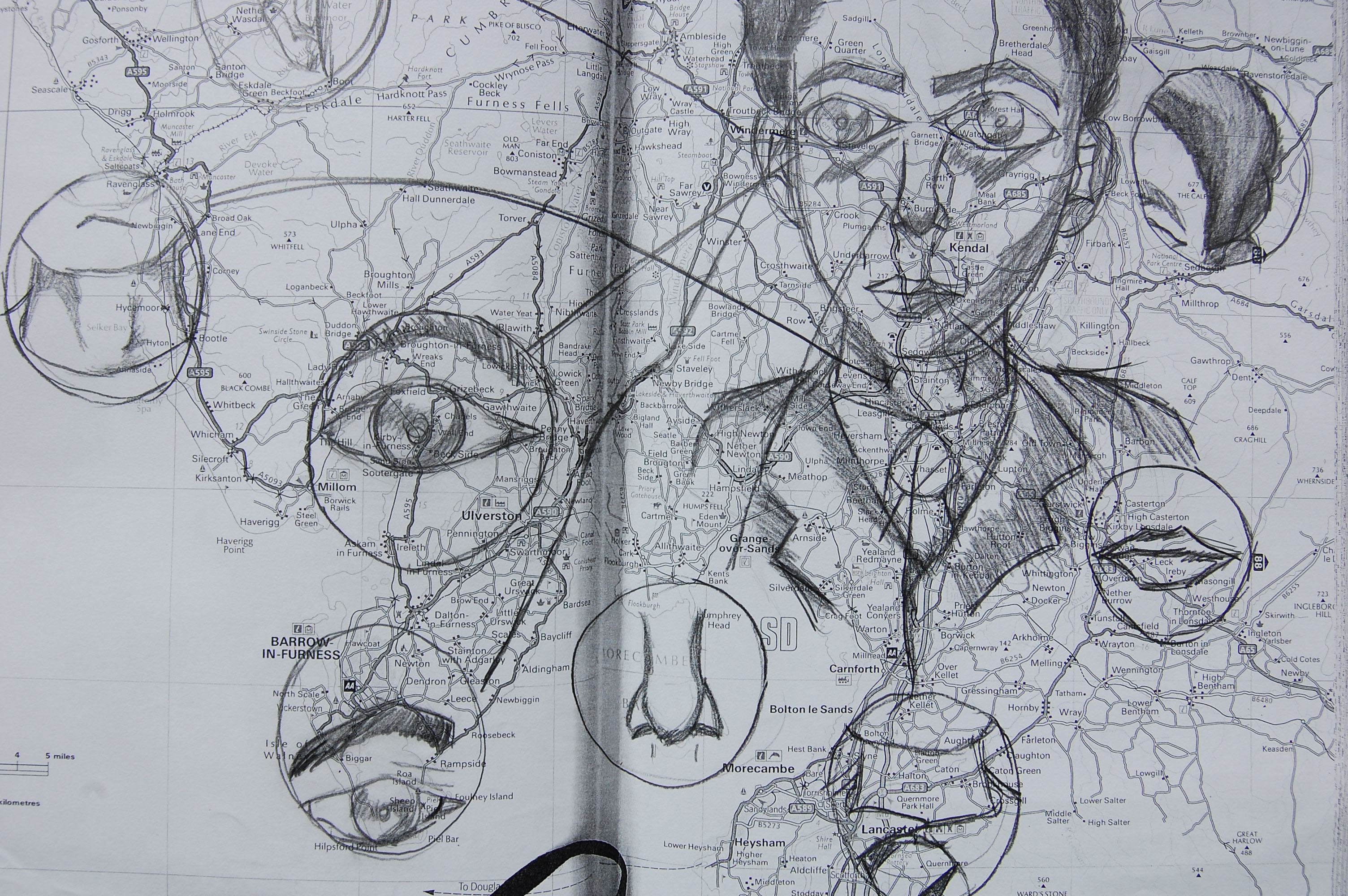Ernest Bevin College - United Kingdom
Region: South London
Other schools in the Quad Blog: Larkin Community College (Ireland), Utsjoen saamelaislukio (Finland), Zs Palachova (Czech Republic)
Creative Connections Project: Mapping

Context
Ernest Bevin College is a single sex boys’ secondary school in the inner city area of Tooting, South London. It has 900 boys aged 11-16, and a co-educational Sixth Form with 375 students. The catchment area, in the London Borough of Wandsworth, is densely populated with a wide variety of housing styles; both rented and privately owned houses and flats. There is a vibrant shopping area nearby with many ethnic restaurants, for which the area is well known in London. The school is an over-subscribed comprehensive school serving the local community. The school is non-denominational and has a specialist college status; specialising in Sport, Mathematics and Computing. The school’s demographic make-up is multi-ethnic, which reflects the local community. As well as the Creative Connections project, the school is involved in other international projects which links schools in China, India and Uganda.
According to the school statistical data, there are:
- 57.5% of pupils with English not as a first language
- 7.7% have Special Educational Needs
- 27.7 % of pupils are entitled to free school meals
The school was as judged 'Outstanding' by Ofsted in 2011.
The art and design teacher was selected to participate in the Creative Connections project at a late stage of the project’s development; as a result she did not come to the training day at the University of Roehampton in November 2012. She was in her second year of art teaching, having come from a Fine Art background including holding a postgraduate degree from the Royal College of Art, London.
The class involved in the Creative Connections project were a Year 9 (13-14 year olds) mixed ability ‘option’ class, which meant that they had elected to take art as a subject because they enjoyed it, but they would not necessarily move into the exam group in the following year.
The Project
The project work in Ernest Bevin focused on the notion of Mapping Identity as well as physical mapping. The art teacher devised her own project by exploiting the celebration of the 150th anniversary of the London Underground transport system, which was on-going at the time the project took place. The focus was essentially about identifying with the local environment (i.e. London), but the idea of mapping, as a more general notion, was introduced by focusing upon a European aspect to develop a sense of ‘place’ the in the first instance. The first session centred upon discussion to elicit the pupils’ attitudes and ideas about themselves as European citizens. The teacher reported that the discussion had been very rich, and stated:
I'm really pleased with how much discussion there was and they have written loads in their books from that. The discussion took up most of the two period lessons, and I gave them just 15 minutes at the end to do whatever they wanted with the tube map. It gave them a real focus to work that quickly and open-endedly and they produced some good ideas very quickly. It was good for their confidence to have a short time frame at that point because they just had to do it!
From the discussion it emerged that four of the group of 26 felt that they did not feel European and another four pupils said they did not feel British. One boy said:
At the beginning of the project I felt European and yet I also didn’t feel European because my heritage is Jamaica.
Another boy had difficulty equating himself to Europe at all:
The first place I lived was Manchester so that's where I feel I belong.
Other comments included:
I feel British but not European.
They showed some stereotypical notions of what it might be like to live in other environments, for example, one boy said:
When I went to Scotland for instance it was so different. In London, I walk quicker and in the countryside they are bit slower to react to things.
Figure 1 European Identity

The pupils were asked to identify any links with Europe, for example, places they might have visited and to plot this on a large map of Europe posted on the classroom wall.
Figure 2 Exploring Europe

The pupils were given a homework which asked them to produce some work relating to aspects of their own identity and to think about how they might express this through mapping. To this challenge the pupils responded in a variety of ways:
- Creating a ‘place mat’ by cutting a map
- A line drawing of a bird made of the colours and style of the London tube map
- Black and white images of London collage
- Three dimensional London view using paper cutting techniques
- Face with European flags around
- Football stickers from EU countries
However, when the researchers visited the class the pupils seemed reluctant to show their work and talk about it to their peers, and although the responses showed a real engagement with the work, many of the boys hid what they had done inside their sketchbooks. One boy had researched the Internet and found information about Europe which he was unwilling to share. Individual pupils said they did not usually have homework as open-ended as this. They explained that usually their homework would be to complete a worksheet. They said that they preferred to work in an open ended way and that the Creative Connections work had given them some freedom to think for themselves.
The teacher introduced a number of contemporary artists through a slide show presentation to inspire the pupils. She said that she preferred to create her own resources and images, rather than use the Creative Connections Image bank:
I've really enjoyed looking for the images in the PowerPoint because it’s something outside what I would normally teach. I can invent something for myself in this project, so it's like being an artist again.
The class worked with various artists such as Henry C Beck’s original tube map design as well as The Great Bear by Simon Patterson
Figure 3 The Great Bear by Simon Patterson

Figure 4 A Bird inspired by mapping

This project built on previous work that the group had completed around creating self-portraits as this fitted in well with the theme of identity. The pupils looked at the work Ed Fairburn and Matthew Cusick in relation to portraits and self-identity. The intention being that the mapping and identity should work together visually to produce a final outcome. The boys were introduced to sculptural skills such as paper cutting and carving, marbling techniques and developed pupils’ drawing skills, and incorporated these in a natural way through the project theme.
Figure 5 An image created by one of the boys, reflecting his drawing skills

Blogging
As with the other three UK schools, the blogging aspect was proved to be a challenge for the teacher as it was difficult for her to find time to upload work within the art lessons. She had asked the boys to post responses to other pupils' work onto QB2 for homework, but only two pupils actually managed to do this. One boy in particular posted a significant amount, and when he was asked about this he said that he had accessed the blog from home, otherwise he would not have done it. Initially four of the boys either lost their passwords or the passwords did not work. Initially the teacher’s login did not work properly and she said that she had spent three hours trying to upload images, but these had gone to the wrong place and this had made her feel rather inadequate. During one visit to the class, the university researcher modelled how to make a response to an image by going through the blogging process with the whole class using the interactive whiteboard. The pupils seemed reluctant to offer comments at first but after some time they had composed a joint response and posted it.
Pupil Response
The pupils responded to the whole project most positively about making the artwork. Some pupils stated that they particularly enjoyed the fact that they could “draw whatever we wanted” relating to the theme, so the notion of pupil ownership over the outcome was important. Others stated that using the website to communicate with others in Europe was the most exciting part of the project. They especially valued being able to comment on artwork and the felt that they:
liked how it connected all the countries together.
One boy stated that:
you could inform people on what you think about their work,
implying that he had realised that his voice and opinion was important enough to be listened to.
When the boys were asked about the sort of comments they made they said:
I said ‘you are a very creative person. You have linked your hobbies into your work.’
I said that the colours were very nice and bright and made it very eye catchy. The whole texture was also quite good.
Yes, I did comment on other people’s work. I said ‘I like the way you use colour and tone in your work about your opinions.’
The class enjoyed the community that was beginning to develop, as expressed by one pupil who said:
I felt like everyone was very friendly and mature when they replied. It felt natural like communicating with your friends.
Teacher Reflection
In her interview evaluation of the project the art teacher said that she would use the project again as it was an adaptable theme to fit with. She said that because of the looseness and freedom within the nature of the subject of art and design it could lend itself well to a more open-ended way of working. She was more surprised that the pupils did not take to the blogging aspect very easily, and wondered whether an app, such as Instagram, or a texting project would have been more instantaneous for them. The digital aspect was a challenge and the uploading of images had been shared between herself, the class technician and the pupils, but even with sharing, it had been too time-consuming. On the whole she felt the pupils’ outlook had been broadened by the project and their awareness of other pupils and people in Europe was raised. The fact that she was able to ‘work like an artist’ had made her reflect critically on her own practice.


